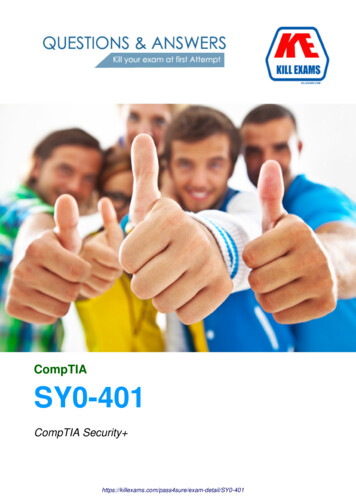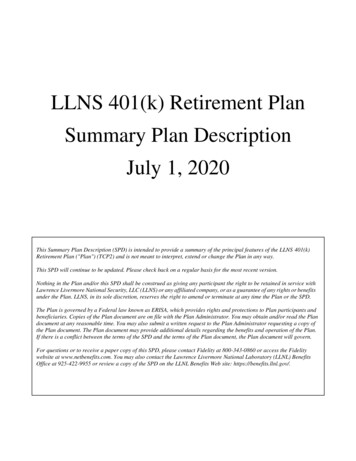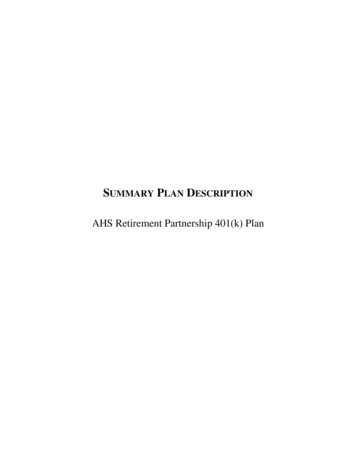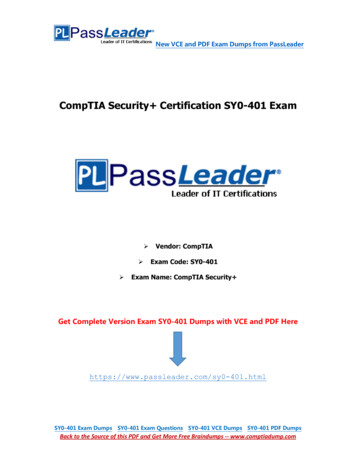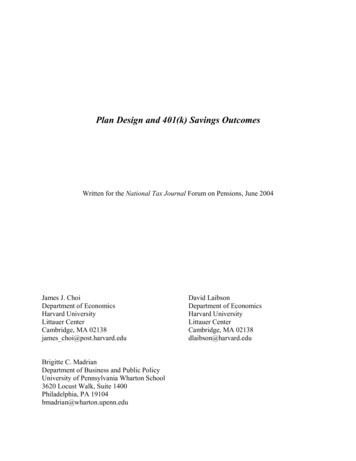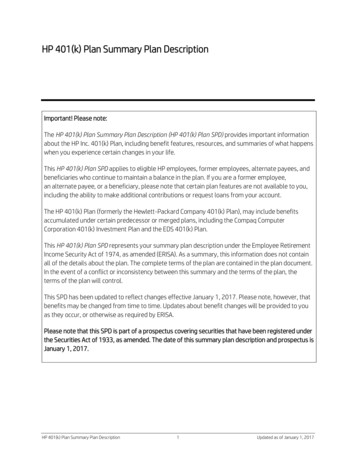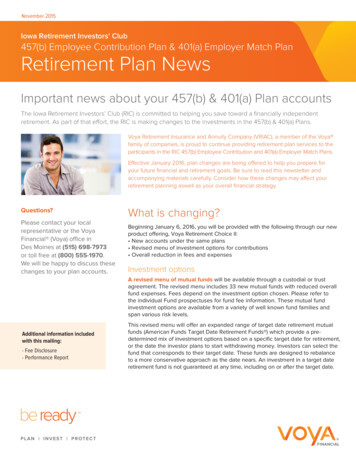
Transcription
LANS 401(k) Retirement PlanSummary Plan DescriptionThis Summary Plan Description (SPD) is intended to provide a summary of the principal features of the LANS 401(k) RetirementPlan (“Plan”) and is not meant to interpret, extend or change the Plan in any way.This SPD will continue to be updated. Please check back on a regular basis for the most recent version and check with the LosAlamos National Laboratory (LANL) Benefits Office for any changes to the Plan that may not have been added to the SPD yet.Nothing in the Plan and/or this SPD shall be construed as giving any member the right to be retained in service with LANS or anyaffiliated company, or as a guarantee of any rights or benefits under the Plan. LANS, in its sole discretion, reserves the right toamend or terminate at any time the Plan and SPD.The Plan is governed by a federal law (known as ERISA), which provides rights and protections to Plan participants andbeneficiaries. Copies of the Plan document are on file with the Plan Administrator. You may obtain and/or read the Plan documentat any reasonable time. You may also submit a written request to the Plan Administrator requesting a copy of the Plan document.The Plan document may provide additional details regarding the benefits and operation of the Plan. If there is a conflict betweenthe terms of the SPD and the terms of the Plan document, the Plan document will govern.For questions or to receive a paper copy of this SPD please contact the LANL Benefits Office at (877) 667-1806 or (505) 667-1806or e-mail benefits@lanl.gov. SPDs are also available electronically at LANL Benefits Web site for Employees athttp://benefits.lanl.gov or LANL Benefits Web site for Retirees: http://www.netbenefits.com.February 20183975047V.11
ContentsThis Summary Plan Description .1Plan Highlights.2How the Plan Works .3Eligibility and Participation .3 Eligibility .3 Enrolling in the Plan .4 When Participation Ends .4Contributions.4 Definition of Eligible Compensation .5 Your Contributions .5 Employer Contributions.10 Contribution Limits .12Managing Your Investments .14 Investment Responsibility .14 Your Investment Choices .14 Changing Your Investment Elections .15 Balancing Risk and Reward.16 Diversification .17 Valuing Your Accounts .17 Investment Management Expenses and Administrative Expenses .17 Keeping Track of Your Accounts .18Taking a Loan .19 How to Apply for a Loan .19 How Much You Can Borrow .20 Loan Fees .20 Tax Consequences .20 How to Repay a Loan .20 If You Default .21 If Your Employment Ends .21 If You Take a Leave of Absence .21Making a Withdrawal .22 Hardship Withdrawals .22 Age 59½ Withdrawals .23 Withdrawals of After-Tax Contributions.23 Military Leave Withdrawals .24LANS 401(k) Retirement Plan3975047V.11iFebruary 2018
Rollover Withdrawals .24 How to Request a Withdrawal .24Receiving a Final Distribution .24 Eligibility to Receive Benefits .24 How to Request a Distribution .24 Receiving Your Benefit .25 When to Take Your Distribution .25 Form of Distribution Payment .25 Partial or Single Sum Cash Distribution .26 Periodic Payments .26 Rollover Distribution .27 When Distributions Begin .28 Minimum Distribution Requirements .28 Interests Not Transferable.28 Duty to Keep Plan Administrator Informed .29 How to Obtain More Information .29If You Die .29 Designating a Beneficiary.29 Death Benefits .30Rules, Regulations and Administrative Information .30 Your Rights under the Employee Retirement Income Security Act of1974 (ERISA) .30 Claims and Appeal Procedures .32 General Plan Provisions and Plan Administration.34 Plan Details .36For More Information .38 Where to Get Information .38LANS 401(k) Retirement Plan3975047V.11iiFebruary 2018
This Summary Plan DescriptionThis Summary Plan Description (SPD) summarizes the LANS 401(k) Retirement Plan (“401(k)Retirement Plan” or “Plan”). It has been written, to the extent possible, in non-technicallanguage. If there is any conflict between this summary and the official Plan document, the termsof the Plan document will govern.The LANS 401(k) Retirement Plan is subject to the provisions of the Employee RetirementIncome Security Act of 1974, as amended (“ERISA”) and the Internal Revenue Code of 1986, asamended (“the Code”).Participation in the Plan and/or receipt of this SPD is not a guarantee of employment or of anybenefits under the LANS 401(k) Retirement Plan.The provisions in this SPD describe the Plan as amended and restated as of January 1,2016 and in effect on January 1, 2018 and replace the December 1, 2012 version of the SPD.LANS 401(k) Retirement Plan3975047V.111February 2018
Plan HighlightsKey Features of the Retirement Plan In order to participate in the 401(k) Retirement Plan,– You must be classified as an employee on the Los Alamos National Security,LLC (“LANS”) payroll system;– You must not be a Student Employee of LANS (the “Employer”) (as definedbelow) or a Laboratory Associate, Retired Laboratory Fellow, museum host orLaboratory Director Emeritus;– You must not have elected to participate in Total Compensation Package 1(“TCP1”) when you were first hired by LANS or, if you did make such anelection, you must be a “TCP2 Rehire” (as defined below); and– You must not be eligible to participate in the LANS 401(k) Savings Plan, oraccruing benefit accrual service in the LANS Defined Benefit Pension Plan(TCP1 defined benefit pension plan).If you are classified as an independent contractor, independent consultant, non-employeeconsultant or leased employee of LANS, you are not eligible to participate in the 401(k)Retirement Plan. Employees whose terms of employment are subject to a collectivebargaining agreement are not eligible to participate unless participation is specificallyprovided for in such agreement. A “Student Employee” means an Employee who has not completed a bachelor'sdegree or equivalent at an accredited college or university and who is classified by theEmployer as a student employee in the Employer's human resource informationsystem or any of the payroll categories used to designate student status. Employeeswho are graduate research assistants or are enrolled in a post-bachelor's degreeprogram while performing services for the Employer shall not be considered “StudentEmployees.”A “TCP2 Rehire” is an individual who– elected TCP1 when first hired by LANS,– terminated employment with LANS,– was rehired in a position other than a Laboratory Associate or Retired LaboratoryFellow, and– if termination was due to an employer-initiated involuntary termination (otherthan for cause) as a result of which the individual would otherwise be eligible toresume active participation in the TCP1 defined benefit pension plan, theindividual's rehire date was more than 3 years after the date of the involuntarytermination.You may contribute to the Plan on a before-tax or after-tax basis, including a Roth401(k) after-tax contribution.LANS 401(k) Retirement Plan3975047V.112February 2018
When you contribute to the Plan, LANS matches 100% of the first 6% of yourEligible Compensation that you contribute to the Plan.LANS also makes an additional “non-elective” employer contribution to your 401(k)Retirement Plan account; the amount of the contribution depends on your years ofservice.You control how your savings are invested.How the Plan WorksYou may authorize before-tax or after-tax contributions, including Roth 401(k) contributions, tothe 401(k) Retirement Plan. The 401(k) Retirement Plan also includes contributions from LANSthat match a percentage of your contributions, as well as an additional “non-elective” employercontribution. You also may request that the 401(k) Retirement Plan accept certain rollovercontributions from certain types of retirement plans on your behalf.You control how your Plan account is invested by directing your contributions, including LANScontributions, into funds in the Plan’s investment lineup. Keep in mind that participating in the401(k) Retirement Plan involves investment risk. If the value of your investments increases ordecreases, so does the value of your 401(k) Retirement Plan account.This summary is not intended to provide personal tax or investment advice. Because everyone’sfinancial situation is different, you should consult a qualified tax or financial advisor beforemaking decisions about your 401(k) Retirement Plan benefits. Tax laws are complicated andoften change, and it is important that you assess your situation in light of current laws.Eligibility and ParticipationEligibilityIn order to participate in the 401(k) Retirement Plan: You must be classified as an employee on the LANS payroll system, You must not be a “Student Employee” (as defined above in Plan Highlights) or a LaboratoryAssociate, Retired Laboratory Fellow, museum host or Laboratory Director Emeritus, You must have provided the Plan Administrator with your Social Security number, and You must not have elected to participate in Total Compensation Package 1 (“TCP1”) whenyou were first hired by LANS (if you were eligible to make such an election) or, if you didmake such an election, you must be a “TCP2 Rehire” (as defined above in the “PlanHighlights”).If you are classified as an independent contractor, independent consultant, non-employeeconsultant or leased employee of LANS, you are not eligible to participate in the 401(k)Retirement Plan. Employees whose terms of employment are subject to a collective bargainingagreement are not eligible to participate, unless participation is provided for in such agreement.LANS 401(k) Retirement Plan3975047V.113February 2018
Employees who are eligible to participate in the LANS 401(k) Savings Plan or are accruingbenefit accrual service in the LANS Defined Benefit Pension Plan are not eligible to participate.Enrolling in the PlanGenerally, upon commencement (or re-commencement) of employment, Fidelity, the Planrecordkeeper, will provide you with an enrollment kit. You will have the opportunity to elect tomake before-tax Contributions, Roth 401(k) contributions, and/or after-tax contributions, directthe investment of your account and designate a beneficiary.If you are eligible to participate and you do not make an affirmative election to defer aspecific percentage of your Eligible Compensation within the time period designated, youwill automatically be enrolled in the Plan. Participants who are automatically enrolled willhave 6% of “Eligible Compensation” (described below) contributed to the Plan as before-taxcontributions. Such before-tax contributions will continue until you either change the amountand/or type of the contribution or make an election to terminate your before-tax contributions(See “Before Tax Contributions” for more details.)If you are an eligible employee, you are automatically enrolled in the Plan's non-electiveemployer contributions feature.As soon as you become an eligible employee, you should contact Fidelity, the Plan recordkeeper,to name a beneficiary and select your investments. For contact information, see “For MoreInformation” at the end of this SPD. For beneficiary information, see “If You Die” and forinvestment information, see “Managing Your Investments.”When Participation EndsIf you are an eligible Plan participant, your participation in the 401(k) Retirement Plan willcontinue until you die or until all your Plan benefits have been distributed, whichever occursfirst. You will not be able to make contributions to the Plan nor will “non-elective” employercontributions be made on your behalf after you terminate employment with LANS, or during aleave without pay. However, if you have an account balance in the Plan following termination ofemployment or while on an unpaid leave, you may make a rollover contribution to the Planunder the rollover provisions discussed below. Special rules apply during certain military leaveperiods.ContributionsThis section describes the allowable contributions to your account. All contributions to the401(k) Retirement Plan are 100% vested at all times.Contributions to your account may include: Your before-tax, Roth 401(k), after-tax, and catch-up contributions An employer matching contribution on the first 6% of Eligible Compensation you contributeLANS 401(k) Retirement Plan3975047V.114February 2018
An additional “non-elective” employer contributionRollover contributionsAll contributions except for your rollover contributions are calculated based on your “EligibleCompensation.” (See “Definition of Eligible Compensation” below.)Definition of Eligible CompensationFor purposes of the 401(k) Retirement Plan, “Eligible Compensation” means—for each payperiod—only your base pay or base wages (including pay in lieu of notice at termination),overtime pay and shift differential which is paid by LANS for services performed while you arean eligible employee. If you receive payments for base pay, overtime pay or shift differentialafter you terminate employment with LANS, that pay will only be Eligible Compensation if youreceive it by the end of the year in which your employment with LANS terminates or within 21/2 months of termination, if later. Any base pay you receive from LANS while you are on aMilitary Leave of Absence, referred to as “differential pay”) (see “If You Take a GovernmentService Approved Leave or Military Leave of Absence” for a description) is also EligibleCompensation. Other compensation, including incentive pay, lump sum vacation payout andseverance pay, are not included in Eligible Compensation. Eligible Compensation only includespay that you receive for work performed under Contract Number DE-AC52-06NA25396between LANS and the Department of Energy related to the operation of the Los AlamosNational Laboratory while you are eligible for Plan participation. Eligible Compensation isdetermined before taxes, and before your contributions to the 401(k) Retirement Plan and anybefore-tax contributions you may make in connection with welfare benefit plans, for exampleyour before-tax contributions to a flexible spending account or health savings account.Each year, federal law sets a limit on the amount of your Eligible Compensation that can betaken into account under the 401(k) Retirement Plan. (See “Contribution Limits” for moreinformation.)Your ContributionsYour before-tax, Roth 401(k) and after-tax contributions are deducted from your paycheck eachpay period and change automatically when your Eligible Compensation changes. Allcontributions are subject to legal limits. (See “Contribution Limits” for details.) LANS helpsyour 401(k) Retirement Plan account grow by making employer contributions to your 401(k)account. (See “Employer Matching Contributions” and “Non-Elective Employer Contributions”for details.)Before-Tax ContributionsOnce you are eligible to participate in the 401(k) Retirement Plan, you may choose to contributeup to 75% of your “Eligible Compensation” on a before-tax basis in 1% increments, subject tolegal limits (see “Contribution Limits”) and less any amounts contributed as Roth 401(k) andafter-tax contributions.LANS 401(k) Retirement Plan3975047V.115February 2018
If you are eligible to participate and you do not voluntarily enroll by making an affirmativeelection to defer a specific percentage (including 0%) of your Eligible Compensation (either as abefore-tax contribution, Roth 401(k) contribution or after-tax contribution), you will beautomatically enrolled. If you are automatically enrolled, you will be deemed to have made anelection to contribute 6% of your Eligible Compensation to the Plan as a before-tax contribution.You may make or change your contribution rate at any time by calling Fidelity or logging on tothe Fidelity Web site. For contact information, see “For More Information” at the end of thisdocument.Before-tax contributions are deducted from your Eligible Compensation before federal incometaxes, and (in most cases) state and local income taxes are determined. By choosing the beforetax savings option, you pay no income taxes on your contributions or their investment gainswhile they remain in the 401(k) Retirement Plan. However, your before-tax contributions areincluded in your gross earnings for purposes of calculating your Social Security and Medicaretaxes and benefits.Before-tax contributions and the associated net investment earnings will be subject to incometaxes when distributed from the Plan.Roth 401(k) ContributionsYou may also elect to make Roth 401(k) contributions which are after-tax contributions deductedfrom your salary after applicable taxes are withheld. If you withdraw the Roth 401(k)contributions at least five tax years after your first Roth 401(k) contribution to the Plan and youare at least age 59½ , the earnings on the Roth 401(k) contributions are also paid to you tax-free.The Roth 401(k) contributions are subject to the same contribution, withdrawal and distributionrules as apply to before-tax contributions, but all taxes are withheld on Roth 401(k) contributionswhen deducted from your pay. Roth 401(k) contributions are different from after-taxcontributions which do not qualify for tax-free earnings. If you die, your beneficiary may beable to receive a distribution of the earnings on your Roth 401(k) contribution tax-free if youstarted making Roth 401(k) contributions at least five tax years prior to the distribution. If youbecome disabled, your earnings on the Roth 401(k) contributions can be withdrawn tax-free if ithas been at least five tax years from your first Roth 401(k) contribution.Before-Tax and Roth 401(k) Contribution LimitsEach calendar year, you can save on a before-tax and/or Roth 401(k) contributions basis up tothe annual maximum dollar limit provided in federal law. If you are a “highly compensated”employee, a lower limit may apply due to nondiscrimination testing. (See “Special Limitation forCertain Highly Compensated Employees.”) The annual maximum dollar limit for 2018 is 18,500, and includes all before-tax contributions and Roth 401(k) contributions you make tothis Plan and any other 401(k) or 403(b) plan in which you participated in that year. Thereafter,increases in the contribution limit may be linked to cost-of-living increases pursuant to federallaw. (See “Contribution Limits” for more information about other limits that may apply to you.)LANS 401(k) Retirement Plan3975047V.116February 2018
After-Tax ContributionsAfter-tax contributions are deducted from your salary after applicable taxes are withheld. Youmay elect to contribute up to 75% of your compensation in 1% increments on an after-tax basis,less any contributions you elected to make on a before-tax basis or as Roth 401(k) contributions.The net investment gains on your after-tax contributions are subject to the same tax treatment asyour before-tax contributions, employer matching contributions, non-elective employercontributions and investment gains or losses on those contributions. For example, investmentgains on after-tax contributions are tax-exempt while they remain in the Plan, and taxed whendistributed to you. This differs from Roth 401(k) contributions which may have their earningsdistributed tax-free (as described above under “Roth 401(k) Contributions”).Catch-Up ContributionsIf you will turn age 50 by the end of any calendar year, you may elect to make additional beforetax contributions including Roth 401(k) contributions—known as “catch-up contributions”—inthat year and following years. Catch-up contributions allow you to increase your savings in orderto help your retirement savings catch up with your retirement needs. In order for before-tax orRoth 401(k) contributions you make to be designated as catch-up contributions, you must firstcontribute the maximum amount of before-tax and Roth 401(k) contributions permitted to thePlan, which is the lesser of 75% of your Eligible Compensation or a dollar limit which for 2018is 18,500. This dollar limit is linked to cost-of-living increases pursuant to federal law. (See“Contribution Limits” for details.)Catch-up contributions are deducted from your paycheck on a before-tax or Roth 401(k) basis,the same as your regular before-tax or Roth 401(k) contributions. Catch-up contributions are inaddition to your regular 401(k) Retirement Plan before-tax or Roth 401(k) contributions, and aredeposited into the same before-tax or Roth 401(k) contribution account.Once you have contributed the maximum regular before-tax and Roth 401(k) contributionsallowed for you for that year, if you are eligible that year to make catch-up contributions, catchup contributions will automatically be deducted from your paycheck until you change yourbefore-tax or Roth 401(k) contribution election or you reach the annual catch-up contributionlimit. If a lower limit on your before-tax and Roth 401(k) contributions applies to you becauseyou are “highly compensated,” the lower limit applies, and any additional contributions youmake will be treated as catch-up contributions.Annual Catch-Up LimitsYour catch-up contributions will be made through payroll deductions and cannot exceed theannual limit, which is 6,000 for calendar year 2018. If you are eligible to make catch-upcontributions and are making before-tax or Roth 401(k) contributions under more than one plan,your total before-tax and Roth 401(k) contributions to all plans in a calendar year cannot exceedthe annual deferral limit for that year ( 18,500 for 2018) plus the annual catch-up for that year( 6,000 for 2018). Thus, for 2018, your total before-tax contributions and Roth 401(k)contributions cannot exceed 24,500 ( 18,500 annual deferral limit plus 6,000 catch-up limit).LANS 401(k) Retirement Plan3975047V.117February 2018
These limits are set by federal law. (See “Contribution Limits” for more information about otherlimits that may apply to you.)Rollover ContributionsYou may choose to roll over money into the 401(k) Retirement Plan from another eligibleretirement plan. (See “Eligibility” for information on eligibility rules.) LANS does not matchrollover contributions, but they will be deposited into your rollover account, and you may investthem on a tax-favored basis just as you do other contributions.To make a rollover contribution, you must be entitled to receive a distribution from an eligibleretirement plan, such as a traditional IRA (not a Roth IRA) or another employer’s plan. A RothIRA may only be rolled over to another Roth IRA.The other employer’s plan may be a: Tax-qualified section 401(a) plan, including a section 401(k) retirement plan, Section 403(a) annuity plan, Section 403(b) tax-sheltered annuity plan, or Section 457(b) plan maintained by a state or local government. You may also roll over amounts that were Roth contributions in another employer's 401(k) or403(b) retirement plan.The amount must be payable to you as an employee, alternate payee or surviving spouse, not as anon-spouse beneficiary. (Non-spouse beneficiaries can make rollovers only to IRAs).The amount rolled over must be in cash rather than in the form of property such as planinvestments with one exception. Effective as of October 1, 2008, a rollover may include theamount of a loan that is not in default that is rolled from a qualified plan of a subcontractor ofLANS if the participant who is requesting approval of the rollover is employed by LANS on orafter October 1, 2008 directly from a LANS subcontractor which has transitioned work to LANSand the participant agrees to repay the loan through LANS payroll deductions. The PlanAdministrator must approve the rollover of a loan in accordance with the terms of the Plan.If your rollover contribution is approved, your rollover contribution may be transferred directlyfrom the trustee of the other plan or IRA to the 401(k) Retirement Plan trustee. Alternatively, ifthe other plan or IRA makes a distribution payable to you, you may roll over the amount within60 days of receiving that distribution.If you make a rollover contribution to the 401(k) Retirement Plan, it will be deposited in yourrollover account and tracked separately from your other contributions. You will also need todecide how you want your rollover contributions invested. (For more information, see“Managing Your Investments.”) Your rollover account will be distributed to you or yourbeneficiary according to the terms of the 401(k) Retirement Plan. (See “Receiving a Fin
the 401(k) Retirement Plan. The 401(k) Retirement Plan also includes contributions from LANS that match a percentage of your contributions, as well as an additional "non-elective" employer contribution. You also may request that the 401(k) Retirement Plan accept certain rollover contributions from certain types of retirement plans on your .
